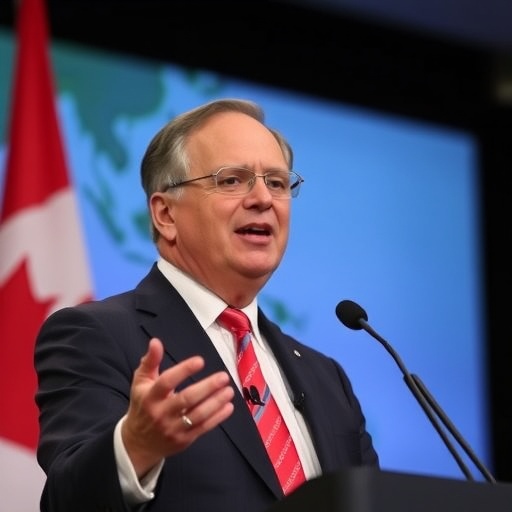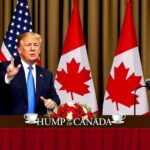Mark Carney Champions Canada’s Rules-Based Trade Reliability at ASEAN Summit Amid US Policy Tensions
In a bold address at the ASEAN Summit in Jakarta, Canadian Prime Minister Mark Carney positioned Canada as a steadfast pillar of the rules-based system, subtly contrasting his nation’s approach with recent US trade policies that have rattled global markets. Carney announced ambitious plans to diversify Canada’s export markets away from over-reliance on the United States, while pledging a significant ramp-up in defence spending to bolster national security in an increasingly volatile world.
- Carney’s Subtle Critique Exposes Cracks in US-Canada Trade Relations
- Unlocking New Markets: Canada’s Push to Expand Non-US Exports
- Defence Spending Surge: Carney’s Bid to Fortify Canada’s Global Stance
- Forging Alliances: Key Outcomes from Carney’s ASEAN Engagements
- Charting Canada’s Future: Implications for Global Trade and Security
The summit, attended by leaders from the 10 ASEAN member states and other Indo-Pacific partners, provided Carney with a high-profile platform to underscore Canada’s commitment to multilateralism. His remarks, delivered on the summit’s second day, highlighted the fragility of international trade norms amid rising protectionism. “Canada stands ready to be a reliable partner in a world that needs more predictability, not less,” Carney stated, drawing applause from delegates who have felt the ripple effects of US tariffs and renegotiated trade deals.
This isn’t just rhetoric; Carney backed his words with concrete initiatives. He revealed that Ottawa aims to increase non-US exports by 25% over the next five years, focusing on high-growth sectors like clean energy technology, agriculture, and critical minerals. Such moves come at a time when Canada-US trade tensions have simmered, with disputes over dairy quotas and softwood lumber exports lingering despite the USMCA agreement. Carney’s emphasis on the rules-based system serves as a diplomatic nudge, reminding allies of Canada’s role as a bridge-builder in turbulent times.
Carney’s Subtle Critique Exposes Cracks in US-Canada Trade Relations
Mark Carney‘s speech at the ASEAN Summit was laced with implications that didn’t escape international observers. Without naming the United States directly, he decried “unilateral actions that undermine the predictability of global supply chains,” a clear reference to the Trump-era tariffs and subsequent Biden administration’s Buy American policies. These measures have cost Canadian exporters billions, with Statistics Canada reporting a 15% dip in cross-border trade volumes in key sectors last year alone.
Carney, a former Bank of England governor known for his economic acumen, drew on his experience to paint a vivid picture of the stakes. “In a rules-based system, we all win by playing fair—tariffs and barriers only invite retaliation and slow global growth,” he said, echoing concerns raised by the World Trade Organization (WTO). The veiled critique resonated particularly with ASEAN nations, many of whom have faced US import duties on steel and electronics, prompting them to seek alternative partners like Canada.
Behind the scenes, sources close to the Canadian delegation indicate that Carney’s team has been quietly lobbying for deeper integration into Asia-Pacific trade pacts. This includes exploring accession to the Comprehensive and Progressive Agreement for Trans-Pacific Partnership (CPTPP), where Canada is already a member, to further insulate against North American uncertainties. The Prime Minister’s words weren’t just diplomatic posturing; they signal a strategic pivot in Canada trade policy, aiming to reduce the US market’s dominance, which currently accounts for over 75% of Canada’s exports.
Experts applaud this approach. Dr. Elena Vasquez, a trade analyst at the University of Toronto’s Munk School of Global Affairs, noted, “Carney’s message is a masterclass in soft power. By touting Canada’s reliability, he’s positioning Ottawa as the go-to partner for nations wary of Washington’s unpredictability.” Her assessment aligns with recent polls showing 68% of Canadians favoring diversification of trade partners, per a Nanos Research survey conducted last month.
Unlocking New Markets: Canada’s Push to Expand Non-US Exports
At the heart of Carney’s ASEAN Summit agenda was a blueprint for expanding Canada trade beyond traditional borders. He unveiled a $2.5 billion federal investment fund dedicated to fostering exports to Southeast Asia and beyond, targeting industries where Canada holds a competitive edge. From British Columbia’s sustainable forestry products to Alberta’s innovative carbon capture technologies, the plan seeks to tap into ASEAN’s booming $3 trillion economy.
Specific targets include boosting agricultural shipments—wheat, canola, and seafood—to Vietnam and Indonesia, where demand is surging due to population growth and urbanization. Carney highlighted a memorandum of understanding signed with the Philippines for joint ventures in renewable energy, projecting $500 million in new trade flows by 2026. “We’re not just selling goods; we’re building partnerships that last,” he emphasized, pointing to Canada’s pristine environmental standards as a selling point in eco-conscious markets.
The numbers underscore the urgency. According to Global Affairs Canada, exports to ASEAN countries grew by 12% in 2023, but still represent only 4% of total Canadian shipments. Carney’s strategy involves deploying trade envoys to key cities like Hanoi and Singapore, alongside digital platforms to connect SMEs with local buyers. This diversification is crucial amid US policy shifts; for instance, the Inflation Reduction Act’s subsidies for electric vehicles have drawn criticism for disadvantaging non-US manufacturers, including Canadian suppliers.
Stakeholders are optimistic. The Canadian Chamber of Commerce praised the initiative, stating in a release, “This is a timely response to geopolitical risks, ensuring Canadian businesses thrive in a multipolar world.” Challenges remain, however, including navigating ASEAN’s diverse regulatory landscapes and competing with China’s aggressive Belt and Road investments. Yet, Carney’s focus on the rules-based system positions Canada as a trustworthy alternative, emphasizing fair labor practices and intellectual property protections.
Defence Spending Surge: Carney’s Bid to Fortify Canada’s Global Stance
Complementing his trade overtures, Mark Carney used the ASEAN Summit to announce a 10% increase in defence spending over the next fiscal year, bringing Canada’s military budget to $35 billion. This move aligns with NATO commitments and responds to escalating Indo-Pacific tensions, including territorial disputes in the South China Sea. “A strong defence is the backbone of a strong economy,” Carney declared, linking security to trade reliability.
The pledge includes procuring advanced frigates for the Royal Canadian Navy and enhancing cyber defence capabilities, with a portion earmarked for joint exercises with ASEAN partners. This isn’t mere symbolism; recent audits by the Department of National Defence revealed gaps in Arctic surveillance and Pacific fleet readiness, vulnerabilities exposed by Russia’s invasion of Ukraine and Houthi attacks on Red Sea shipping lanes.
Carney’s emphasis on defence spending ties directly into the rules-based system narrative. He argued that military strength underpins the stability needed for open trade routes, citing the $1.2 trillion annual cost of global piracy and disruptions. In a side meeting with Singapore’s Prime Minister, Carney discussed intelligence-sharing pacts to counter non-state threats, further solidifying Canada’s role in regional security forums like the ASEAN Defence Ministers’ Meeting-Plus.
Critics at home question the fiscal wisdom, with opposition leader Pierre Poilievre calling it “election-year spending” ahead of federal polls. However, public support is robust, with a Leger poll indicating 72% approval for bolstering defences amid rising global threats. Internationally, the announcement has been welcomed; Australian Foreign Minister Penny Wong tweeted, “Canada’s commitment strengthens our shared vision for a free and open Indo-Pacific.”
This defence ramp-up also has economic ripple effects. Investments in domestic shipbuilding and tech R&D are expected to create 5,000 jobs, per government estimates, while fostering Canada trade in defence exports like radar systems and drones to allied nations.
Forging Alliances: Key Outcomes from Carney’s ASEAN Engagements
The ASEAN Summit wasn’t just speeches for Mark Carney; it yielded tangible diplomatic wins. He secured bilateral deals with Malaysia on critical minerals supply chains, vital for electric vehicle batteries, and with Thailand on food security collaborations to mitigate climate impacts. These pacts build on the Comprehensive Economic Partnership for a Prosperous Asia (CEPA) framework, enhancing Canada trade flows in sustainable agriculture.
Carney also addressed broader geopolitical concerns, advocating for WTO reforms to enforce the rules-based system more effectively. In a panel discussion, he joined Indonesian President Joko Widodo to critique supply chain vulnerabilities exposed by the COVID-19 pandemic and ongoing conflicts. “We’ve learned that resilience requires collective action,” Carney said, proposing a Canada-ASEAN fund for digital infrastructure to support e-commerce growth.
Environmental themes wove through the talks, with Carney touting Canada’s net-zero ambitions as a model for ASEAN’s green transition. A joint statement on biodiversity conservation was issued, pledging $100 million in Canadian aid for mangrove restoration projects in vulnerable coastal areas. These initiatives not only advance diplomatic ties but also open doors for eco-tourism and carbon credit trading, projected to add $300 million to bilateral trade by 2028.
Challenges surfaced too. Discussions on human rights in Myanmar highlighted divisions, with Carney urging ASEAN unity while respecting the bloc’s non-interference principle. Nonetheless, his pragmatic approach earned respect, positioning Canada as a mediator rather than a lecturer.
Charting Canada’s Future: Implications for Global Trade and Security
Looking ahead, Carney’s ASEAN Summit performance signals a transformative era for Canada trade and foreign policy. By prioritizing non-US exports, Ottawa aims to weather economic storms from potential US election outcomes, whether a return to protectionism or continued subsidies favoring domestic industries. Projections from the Conference Board of Canada suggest that successful diversification could add 2% to GDP growth by 2030, cushioning against a possible 20% drop in US-bound shipments.
On the defence front, the spending increase paves the way for enhanced interoperability with allies, including potential contributions to UN peacekeeping in the region. Carney hinted at exploring AUKUS-like tech-sharing arrangements, albeit focused on non-nuclear domains, to counterbalance influence in the Indo-Pacific.
Broader implications ripple globally. As the rules-based system faces strain from superpowers, Canada’s model—blending economic openness with security resolve—offers a blueprint for middle powers. Upcoming G7 and G20 summits will test this vision, with Carney likely pushing for a unified front against trade distortions.
For businesses and citizens, the path forward involves adaptation. Export councils are ramping up training programs for navigating Asian markets, while defence firms eye subcontracts from the expanded budget. In Carney’s words from the summit close, “Canada’s future lies in partnerships that endure—reliable, resilient, and rooted in rules.” As the world watches, these steps could redefine Canada’s place on the global stage, fostering prosperity amid uncertainty.









